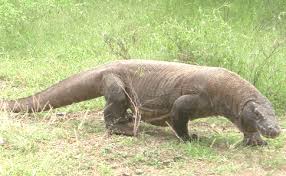KOMODO DRAGON
 |
| In Low Land Habitat |
Komodo Dragon Distribution
People are fascinated by their large size, and fearsome reputation. They can grow up to 6 feet long, with a muscular tail capable of knocking down large deer, and claws several inches long that are used to defend itself as well as disabling prey.
 |
| Toxic Slober |
Although they often feed on carrion, Komodo Dragon's have been known to ambush live animals, using teeth and claws to disable their prey. It was once believed that the Komodo Dragon's live prey died from infection delivered through the saliva, but it has recently been proven that although their saliva does contain numerous bacteria and pathogens, they also have venom glands which deliver a hemotoxin to the victim.
| Using it's tongue to locate prey |
They locate their prey by capturing scent particles on their tongue and passing them over the jacobsen's organ on the roof of their mouth. Using their tongue, they can "smell" prey up to six miles away. Luckily, like most reptiles they eat about 40% of their body weight at a time, but only eat about once per month.
I think one of the most fascinating things about these animals is their reproduction. Unlike most reptiles, Komodo Dragons are capable of forming bonded pairs that mate for life. On the other hand, if no males are available, female dragons are able to use parthenogenesis to reproduce. This means that a female can produce eggs which can hatch, even without the presence of a male. In this case all of the offspring will be male.
| Hiding from Mom and Dad in the Trees |
However, they're not the best parents. Although the mother incubates her clutch of 20 eggs for 6-7 months, when the infants hatch she allows them to fend for themselves. Young Komodo Dragons, make up about 10% of the diet of the adults. For this reason, the young spend most of their early years in the trees eating birds eggs, insects, and smaller lizards.


do the Arctic Tern next! I love those birds - they are crazy resilient.
ReplyDeleteThese are cool, but not quite as cool as real dragons.
ReplyDeleteOh wow - the utterly wondeful Kamodo dragon!!! Completely wild beasts - absolutely terrifyingly sublime in ther reptilian world. And what brilliant reproductive sytems!! Yay!! Amazing animals, amazing creatures. May they continue to thrive! Lovely!! Take care
ReplyDeletex
Definitely don't want to get bit by one!
ReplyDelete